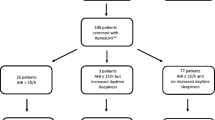Abstract
Purpose
We performed nocturnal polysomnography in patients with pulmonary hypertension (PH) of varying etiologies to determine the association of metrics describing sleep-disordered breathing (SDB) with measures of PH severity.
Methods
Consecutive patients referred for evaluation of dyspnea on exertion and elevated pulmonary arterial pressure >30 mmHg on echocardiography, who underwent right and left heart catheterization and polysomnography, were included. Patients were not pre-selected for symptoms of sleep-disordered breathing.
Results
Twenty-eight patients including 22 females and six males with a mean age of 55.2 ± 11.9 years were evaluated. Etiologies of PH were idiopathic (32%) and PH associated with other diseases (68%). Most were World Health Organization (WHO) Functional class II (39%) and III (39%). The group mean pulmonary arterial pressure (mPAP) was 40.9 ± 15.1 mmHg. Diurnal resting and exercise arterial oxygen saturations (SaO2) were 94.9 ± 3.7% and 88.3 ± 8.9%. The mean apnea–hypopnea index (AHI) was 11.4 ± 19.8/h; 50% of all patients had an AHI ≥ 5/h; 30.6 ± 36.0% of total sleep time was spent with SaO2 < 90% (T90%); 66% of subjects with an AHI ≥ 5/h of sleep reported snoring, and 60% noted daytime somnolence; however, only 29% had an Epworth Sleepiness Scale ≥10. Right atrial pressure and mPAP were significantly correlated with AHI and T90%. The best predictive model relating PH severity to metrics of SDB was a highly significant association (p = 0.005) between mPAP and a linear combination of AHI and T90%.
Conclusions
SDB comprised of obstructive apneas, hypopneas, and nocturnal hypoxemia is prevalent in PH and cannot be accurately predicted by sleep apnea signs and symptoms or diurnal rest and exercise SaO2. The association of AHI and T90% with mPAP suggests a potential relationship between the pathophysiology of sleep-disordered breathing and PH.

Similar content being viewed by others
References
McNicholas WT (2000) Impact of sleep in COPD. Chest 117(2):48–53 (suppl)
Minai OA, Ricaurte B, Kaw R, Hammel J, Mansour M, McCarthy K, Golish JA, Stoller JK (2009) Frequency and impact of pulmonary hypertension in patients with obstructive sleep apnea syndrome. Am J Cardiol 104(9):1300–1306
Rafanan AL, Golish JA, Dinner DS, Hague LK, Arroliga AC (2001) Nocturnal hypoxemia is common in primary pulmonary hypertension. Chest 120:894–899
Atwood CW Jr, McCroy D, Garcia JGN, Abman SH, Ahearn GS (2004) Pulmonary artery hypertension and sleep-disordered breathing. Chest 126(suppl 1):S72–S77
Minai OA, Pandya CM, Golish JA, Avecillas JF, McCarthy K, Marlow S, Arroliga AC (2007) Predictors of nocturnal oxygen desaturation in pulmonary arterial hypertension. Chest 131:109–117
Ulrich S, Fischler M, Speich R, Bloch KE (2008) Sleep-related breathing disorders in patients with pulmonary hypertension. Chest 133:1375–1380
Badesch DB, Abman SH, Simonneau G, Rubin LJ, McLaughlin VV (2007) Medical therapy for pulmonary arterial hypertension. Chest 131:1917–1928
American Thoracic Society (2002) ATS statement: guidelines for the six-minute walk test. Am J Respir Crit Care Med 166:111–117
Barst RJ, McGoon M, Torbicki A, Sitbon O, Krowka MJ, Olschewski H, Gaine S (2004) Diagnosis and differential assessment of pulmonary arterial hypertension. J Am Coll Cardiol 43:S40–S47
Iber C, Ancoli-Israel S, Chesson AL, Quan SF (2007) The AASM manual for the scoring of sleep and associated events: rules, terminology and technical specifications, 1st edn. American Academy of Sleep Medicine, Westchester, IL
Series ATS/ERS Task Force (2005) Standardisation of lung function testing. Numbers 2, 3, 4. Eur Respir J 26:319–338, 511–522; 720–735
Punjabi NM, Caffo BS, Goodwin JL, Gottlieb DJ, Newman AB, O’Connor GT, Rapoport DM, Redline S, Resnick HE, Robbins JA, Shahar E, Unruh ML, Samet JM (2009) Sleep-disordered breathing and mortality: a prospective cohort study. PLoS Med 6(8):e1000132
Young T, Palta M, Dempsey J, Skatrud J, Weber S, Badr S (1993) The occurrence of sleep-disordered breathing among middle-aged adults. NEJM 328:1230–1235
Podszus T, Greenberg H, Scharf SM (1994) Influence of sleep state and sleep disordered breathing on cardiovascular function. In: Saunders NA, Sullivan CE (eds) Sleep and breathing, 2nd edn. Marcel Dekker, New York, pp 257–299
Ward JP, McMurtry IF (2009) Mechanisms of hypoxic pulmonary vasoconstriction and their roles in pulmonary hypertension: new findings for an old problem. Curr Opin Pharmacol 9:287–296
Jeffery TK, Wanstall JC (2001) Pulmonary vascular remodeling: a target for therapeutic intervention in pulmonary hypertension. Pharmacol Ther 92(1):1–20
McNicholas WT (2009) Obstructive sleep apnea and inflammation. Prog Cardiovasc Dis 51:392–399
Belaidi E, Joyeux-Faure M, Ribuot C, Launois SH, Levy P, Godin-Ribuot D (2009) Major role for hypoxia inducible factor-1 and the endothelin system in promoting myocardial infarction and hypertension in an animal model of obstructive sleep apnea. Am Coll Cardiol 53(15):1309–1317
Gjroup PH, Sadauskiene L, Wessels K, Nyvad O, Strunge B, Pedersen EB (2007) Abnormally increased endothelin-1 in plasma during the night on obstructive sleep apnea: relation to blood pressure and severity of disease. Am J Hypertens 20:44–52
Rhodes CJ, Davidson A, Gibbs JS, Wharton J, Wilkins MR (2009) Therapeutic targets in pulmonary arterial hypertension. Pharmacol Ther 121:69–88
Greenberg H, Ye X, Wilson D, Htoo AK, Hendersen T, Liu SF (2006) Chronic intermittent hypoxia activates nuclear factor-kappaB in cardiovascular tissues in vivo. Biochem Biophys Res Commun 343(2):591–596
Htoo AK, Greenberg H, Tongia S, Chen G, Henderson T, Wilson D, Liu SF (2006) Activation of nuclear factor kappa B in obstructive sleep apnea: a pathway leading to systemic inflammation. Sleep Breath 10:43–50
Rabinovitch M (2008) Molecular pathogenesis of pulmonary arterial hypertension. J Clin Invest 118:2372–2379
Conflict of interest
The authors declare that they have no conflict of interest.
Author information
Authors and Affiliations
Corresponding author
Rights and permissions
About this article
Cite this article
Prisco, D.L., Sica, A.L., Talwar, A. et al. Correlation of pulmonary hypertension severity with metrics of comorbid sleep-disordered breathing. Sleep Breath 15, 633–639 (2011). https://doi.org/10.1007/s11325-010-0411-y
Received:
Revised:
Accepted:
Published:
Issue Date:
DOI: https://doi.org/10.1007/s11325-010-0411-y




